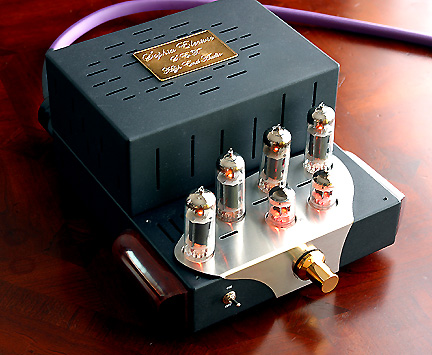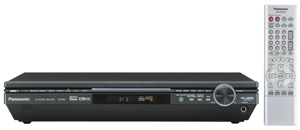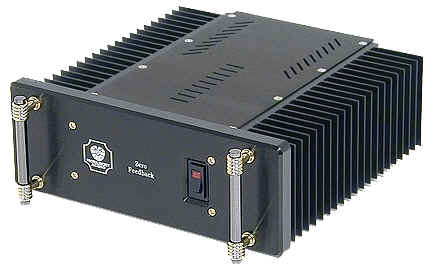Budget-Amp Mini Trilogy
| Budget-Amp Mini Trilogy |
|
Tubes vs. Solid-State With a Side Dish of Digital! |
|
Frank Alles April 2004 |
Prepare yourselves for an epic battle, performed by adept challengers from different disciplines. In one corner we have the Sophia Electric Baby, a 10 Wpc, push-pull, tube design, and in the opposing corner, the Monarchy Audio SM-70 Pro, a solid-state, class-A MOSFET combatant that uses no negative feedback. Both amplifiers are close to the same price point, with the Baby weighing in at $799 and the Monarchy at $980. And attempting to dethrone both of our prospects is the Panasonic SA-XR45 receiver, an unlikely entrant from the all-digital dojo.
The Monarchy SM-70 Pro is more powerful than the Baby, putting out about 35 watts per channel into 8-ohm loads, or 80 watts in mono. I used the very efficient (101 dB/W) Klipsch Chorus speakers to even the playing field for the 10 Wpc Baby. We shall see how well our warriors joust in the following head-to-head encounter. Don your helmets and Oakley’s ladies—this could get messy!
That’s My Baby!
First off, I have to say that the Sophia Baby is a very stylish and appealing little amp. It can be bought with cosmetic enhancements as well as speaker post and capacitor upgrades. My unit is their basic model with the cherry-wood front fascia. It also has the advantage of a handsome gold front panel volume control, allowing a single source component to be plugged directly into its inputs without the need for a preamplifier.
Playing through many of my test CDs, the Sophia Baby displayed some regal traits exceptionally well. It’s linearity and freedom from the usual cliché tube colorations was a welcome surprise. The Baby sounds very natural on all types of acoustic instruments and its transient speed is truly first rate. I recall listening to a recording with a solo violin being played fast and furiously. With lesser amps hearing the violin can be a painful experience, with the instrument sounding blurred and screechy. But the Baby was able to reproduce the nimble bowing with all its micro-changes in pitch and volume while at the same time managing to sound like a real violin. I was impressed. Plus, it’s a very smooth and liquid sounding amplifier, which was not a big surprise, considering its tube topology.
The Baby’s bass articulation is very good. Runs on acoustic bass, the bowing of the cello, and the lower registers of the piano sound quite natural and seamless. That said, the Baby is not as solid and extended in the deep bass as the Monarchy SM-70 Pro.
But, for me, the shortfall of the Baby was its tendency to sound strained and compressed when asked to play moderately loud. In my large 14’x30’ listening room I sometimes felt the need for just a dB or two more than the Baby could comfortably provide. I have heard comments from other audiophiles that the Baby can comfortably power speakers of about 90 dB/W or greater efficiency, but I suppose they like to listen at lower levels than I do or have smaller rooms. However, when used within its power limits, the Baby is a very excellent amplifier. In fact, when playing Diane Schuur’s vocal on “The Christmas Song” from A GRP Christmas Collection [GRP GRD-9574], I was taken aback by the Baby’s vivid, lifelike rendering. It was literally the best I have ever heard this recording sound.
Enter the Dragon
When I first installed the SM-70 Pro in my Klipsch system, there was an unusual occurrence. I began my listening with Shaggy’s Hotshot CD [MCA 888 112 096-2] and noticed that the lyrics seemed much harder to understand than they were when using the Baby. Indeed, my wife commented from the next room that the singer sounded like he had marbles in his mouth. Hotshot is a good test for lyric intelligibility because Shaggy sings/speaks the words so fast that they are difficult to catch unless everything in your system is working very well.
At any rate, I had just received another pair of Analog Two interconnects from SignalCable and I decided to replace Gary Markowitz’s Remarkable cables with those. After inserting the Analog Twos between my preamp and the SM-70, an interesting thing happened. Replaying the Shaggy cuts that had previously sounded muddled, Shaggy’s voice was now more “human” sounding, and much easier to understand. It appeared that the Baby still held a slight advantage in terms of ultimate speed and lyric comprehension, but now the two amps were comparable, and the difference was slight. Curiously, reinstalling the Baby amp and trying it with the SignalCable interconnects did not appear to make it sound any better than it had with the Remarkable cables.
In using the Monarchy SM-70 Pro I discovered that the hum and noise from the amp was somewhat of an issue with the 101 dB efficient Klipsch. By contrast, the Baby was VERY quiet. But with the Monarchy, I could hear the hum from my listening seat when all was quiet and found it a little distracting. At that point I contacted Monarchy’s C.C. Poon to find out if the input circuit of the SM-70 Pro could be adjusted for less gain, and hopefully, less noise. Mr. Poon assured me that this could be easily accomplished by changing the value of two resistors in the input stage and agreed to perform the modification on a second sample.
Dragon Slayer?
Then, one day, whilst perusing the for-sale ads on Audiogon.com, I chanced to spy an unusual ad from John Meyer of Newform Research. It proclaimeth that the Newform R645 speakers will sound oh-so-delightful, when bi-amped using the Panasonic SA-XR45 all-digital receiver. John explaineth how the Wizards of Panasonic went to the Thaumaturgists of Texas Instruments to consult and conspire on the arcane art of 1’s and 0’s. Subsequently, they developed an advanced digital receiver that could be sold for the price of topsoil. Could it be?
I figured that no self-respecting audioknave could pass up an opportunity, nay, a challenge, like that, so for all of $300 (best price I found on the Internet) I was determined to find out for myself.
First, let me make it clear that the Panasonic SA-XR45 is a Dolby-Digital, 6-channel receiver, not a basic stereo amplifier. But audiophiles have found that it performs very well when used as a stereo amplifier via its direct digital input, or with an analog source via its direct, 6-channel analog inputs. Another simple modification that I adopted was the use of an inexpensive IEC adapter, which allowed me to use a higher quality power cord.
After installing the Panasonic in my system and letting it burn in for a couple of days, I sent the following brief assessment to a friend of mine:
I have bloom, I have presence, I certainly have dynamics and extremely clear, full-range sound. The bass is rock-solid and very articulate and natural. The clarity and detail may be better than any of my other amps. Guitar strings, cello, piano, and woodwinds sound very convincing and brasses sound very good, although I have heard better. Vocal reproduction is very competent and surely above average, while lyric comprehension is strictly first rate. There may be a slight coloration in the highs, but it is not too distracting.
While my initial impression of the XR45 was very positive, I had overlooked certain quirks in its performance that started to bother me over time. For some reason, it just didn’t sound totally convincing when reproducing brass instruments, and although the high frequencies were rendered very well, something about the treble was not quite spot on—but it was close.
Return of the Dragon
I’ll admit it, I was actually very pleased with the Panasonic XR45 in my system and I was definitely enjoying its remote control, which gave me volume, channel selection, and muting capability from my listening seat. I could even play its AM/FM tuner and switch the stations. Ha! What more could I possibly want?
Then, as fate would have it, one day upon my return from work I noticed a familiar white box with blue lettering lying on my foyer floor.
The very next day, I unboxed the updated Monarchy SM-70 Pro and reluctantly put it back in my system. I didn’t expect it to sound much (if at all) better than the XR45, and I had gotten rather used to that beguiling remote control. Arrrrgghh!
Then, upon firing it up and hearing the splendor and magnificence of its sound, my feelings of reluctance faded. I began enjoying a musical feast fit for a king—or at least, an audioknave. Best of all, with the input gain modification, this SM-70 Pro was quiet. Yes, one could hear a bit of hiss with one’s ear right up to the speaker, but it was not audible a few feet away, and the hum was totally banished.
NOTE: This is the latest, much-improved version of the SM-70 Pro amplifier and the details of the changes are outlined following this review. As a courtesy to present SM-70 owners, Monarchy’s C.C. Poon has agreed to perform the input modification to any version free if the owner agrees to pay the full shipping charges to and from Monarchy audio. This offer is only for installation of the input gain resistors and does not include any other upgrades or modifications to the amplifier.
What clobbered me over the head was listening to Alicia Keys’ Songs In A Minor [J-Records JB 20002]. Her vocal pierced my tympanic membrane right through to my heart, which gave rise to the fabled gooseflesh. And her nimble fingers on the ivories struck chords so natural and pure that I sat transfixed and was transported to a place we seldom reach in our myriad audio journeys. That’s when I knew the Dragon had returned.
I had previously listened to the aforementioned Alicia Keys CD on the XR45 and it did not provide the same transparent, soul-reaching experience. The bass and dynamics were there in full force, as was the clarity, but the harmonic rightness of the midrange and treble was not up to the high standard of the Monarchy’s performance. Instead of being drawn in to the experience, I was somewhat put off by it.
Playing several selections from the Squirrel Nut Zippers’ Hot [Mammoth 354 980 0137-2] confirmed my impression that the Panasonic could not get the brasses quite right. Here the Monarchy amp ruled, and managed to sound musical and captivating while doing so. The timber of the various brass horns was much more natural through the SM 70 Pro.
Happily Ever After…
The moral of this story is that we have three glorious competitors, each with their own special set of strengths and failings.
To sum up, the Sophia Baby in my estimation is the most natural and musical of the trio, but is lacking in headroom and bass extension/solidity. Also, it tends to sound harsh when pushed. Yet the Baby is hard to beat when paired with high efficiency speakers played at low to moderate levels. It would likely sound great driving the midrange and tweeters in a high-efficiency, bi-amped system, as well.
The Monarchy SM-70 Pro is very nearly the Baby’s equal in terms of timbre and musical truth, but it can play much louder without strain and is more authoritative in the low bass. Of the three amps, it is my personal hero. A pair of SM-70s can be used as bridged monoblocks in installations where higher power is needed.
I was VERY impressed with our lowest-cost, digital competitor from Panasonic. The SA-XR45 lacks the immediacy and harmonic rightness of the Baby and the SM-70 Pro, but it acquits itself admirably in terms of bass extension and articulation, dynamic capability, and clarity (freedom from congestion with complex material). It runs cool, is energy efficient, and has remote control. Putting out 100 watts per channel into 6 ohms, the SA-XR45 is the most powerful amp in this group. Wayne Waananen of the Bolder Cable Company (famous for his ART D/IO D/A converter mods) offers a modification package for $700 that reportedly improves the performance dramatically.
Following are the specifications and company information, and finally, my Associated Equipment list for this review. Happy listening!
Sophia Electric, Inc.
Washington, DC
Voice: (703) 204-1429
Fax: (703) 560-3502
E-mail: sales@sopohiaelectric.com
Website: www.sophiaelectric.com
Baby Specs:
Power: 10 watts x 2 Push and Pull class A circuit
Input: One set of RCA input
Output: Russian Military 6P1T x 4 (with special treatment for low noise)
Input/Driver tube: NOS 5670 (USA)
Frequency: 6Hz-80KHz +/-3 dB
or 10Hz – 50KHz +/-2 dB
12Hz – 45KHz at 0 dB
Signal/Noise Ratio: -95dB
Distortion: less than 1% at full power
Hum: not measurable (less than 0.3mV)
Weight: 20 pounds
Size: 7 inch x 9 inch x 5 inch
Price: $799.00 to $899.00 depending on options.
Monarchy Audio
380 Swift Ave., #21
S. San Francisco, CA 94080
Voice: 650-873-3055
Fax: 650-588-0335
Email: monarchy@earthlink.net
Website: www.monarchyaudio.com
SM-70 Pro
Weight: 25 lbs.
Price: $980
Recent Upgrades:
1: Epoxy-filled toroidal transformer (for lower noise)
2: Higher Power Output MOSFETS (old version: each MOSFET 7 amps/160Volts)
(New version: each MOSFET 8 amps/200Volts)
3: Easier Service: The MOSFETS are mounted on aluminum strips; on old
version they were mounted on the chassis.
4: Lower Input impedance: 70K instead of 100K to match preamps better.
5: All WIMA audiophile grade caps in signal paths for better sound quality.
6: Laser Engraved rear panel for better cosmetics and identification.
7: Some refinements on Component values
8: 50 Volt Electrolytics (older version 35 Volt) at filtering
9: Heavier top and rear panels (for more sturdy look and feel)
10: Improved construction techniques.
Panasonic Consumer Affairs
Panazip 2F-3
One Panasonic Way
Secaucus, NJ 07094
Phone: 800-211-PANA (7262)
Website:http://www.panasonic.com/consumer_electronics/home/flash.asp
Panasonic SA-XR45
Power Output
Home Theater Mode —
Front: 100W/Ch x 2 (1 kHz, 6 ohms, 0.9% THD)
Center: 100W (1 kHz, 6 ohms, 0.9% THD)
Surround (Left Surround, Right Surround): 100W/Ch x 2 (1 kHz, 6 ohms, 0.9% THD)
Surround Back: 100W (1 kHz, 6 ohms, 0.9% THD)
Stereo Mode — 100W/Ch x 2 (10Hz-20kHz, 6 ohms, 0.9% THD)
Frequency Response 10Hz-44kHz, &plusm;3dB
S/N (IHF A)
Digital Input — 98dB (IHF ’66)
Load Impedance 6-8 ohms
Frequency Range
FM Tuner — 87.9-107.9 MHz
AM Tuner — 530-1710 kHz
Universal Remote Control
Weight 9.2 lbs.
Dimensions (H x W x D)
2-29/32″ x 16-15/16″ x 14-3/4″
MSRP: $499.00
![]()
Stereo Times Masthead
Publisher/Founder
Clement Perry
Editor
Dave Thomas
Senior Editors
Frank Alles, Mike Girardi, Russell Lichter, Terry London, Moreno Mitchell, Paul Szabady, Bill Wells, Mike Wright, and Stephen Yan,
Current Contributors
David Abramson, Tim Barrall, Dave Allison, Ron Cook, Lewis Dardick, John Hoffman, Dan Secula, Don Shaulis, Greg Simmons, Eric Teh, Greg Voth, Richard Willie, Ed Van Winkle, Rob Dockery, Richard Doran, and Daveed Turek
Site Management Clement Perry
Ad Designer: Martin Perry





Be the first to comment on: Budget-Amp Mini Trilogy